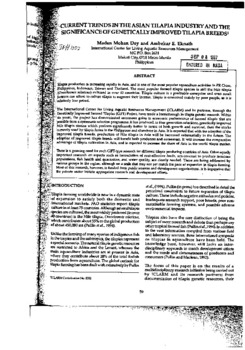Current trends in the Asian tilapia industry and the significance of genetically improved tilapia breeds

Citation
Dey, M.M.; Eknath, A.E. (1997). Current trends in the Asian tilapia industry and the significance of genetically improved tilapia breeds. In: Sustainable aquaculture. INFOFISH-AQUACULTURE '96: International Conference on Aquaculture, Kuala Lumpur, Malaysia 25-27 September 1996. Kuala Lumpur, Malaysia. INFOFISH. p. 59-78
Tilapia production is increasing rapidly in Asia, and is one of the most popular aquaculture activities in PR China, Philippines, Indonesia, Taiwan and Thailand. The most popular farmed tilapia species is still the Nile tilapia (Oreochromis niloticus) cultured in over 40 countries. Tilapia culture is a profitable enterprise and even small farmers can afford to culture tilapia to augment their income. Tilapia is consumed mainly by poor people, as it is relatively low priced. The focus of this paper is on the results of a multidisciplinary research initiative being carried out by ICLARM and its research partners; from documentation of tilapia genetic resources, their systematic characterisation, evaluation, and utilisation in applied national fish breeding programmes, to monitoring of the adoption of genetically improved tilapia breeds with due regard to their impact on equity, environment, and hiodiversity. To provide an Asian development context and the relevance of this major research initiative, the discussion begins by a description of the current status of the tilapia industry in Asia including a brief history of tilapia introductions in Asia, tilapia farming systems, tilapia prices, and international trade in tilapia.
Permalink
Date Available
Type
Publisher
Research Themes
Language